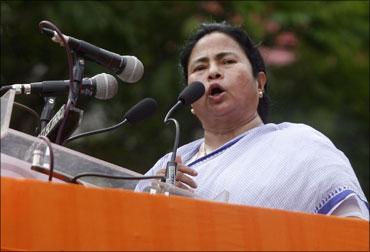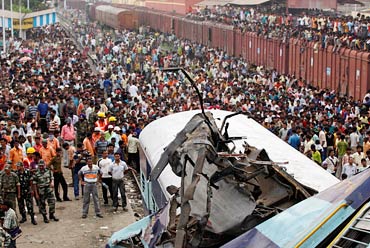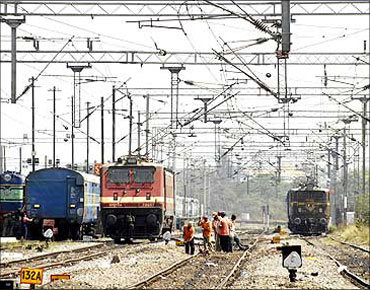
Now that Railway Minister Mamata Banerjee has decided to embark on her maiden foreign tour after becoming a minister in the United Progressive Alliance government, her advisors may like to do some homework on what she can tell her English hosts on how the Indian Railways has performed under her charge in the last 16 months.
She will, of course, prefer to talk about Singur, Nandigram and her 'Three-M' slogan -- Maa, Maati and Maanush (roughly translated, they mean Mother, Mother Earth and Man!).
But she also needs to be prepared to face some hard questions during her tour on the performance of the Indian Railways. She may wonder why, but her advisors should know the reasons. The Indian Railways has a lot to worry about these days.
Take, for instance, the Indian Railways' latest performance numbers during the first four months of the current financial year. Its freight traffic grew less than 3 per cent and earnings from freight went up by only 8 per cent.
Indeed, the Indian Railways' earnings from goods traffic grew at a lower rate of 7 per cent for the four-and-a-half month period of 2010-11. This is certainly better than the 6 per cent growth target set for the full financial year and the railway minister may well start celebrating what she will describe as her triumph.
. . .

That, however, is not the real story. The more important question Banerjee must answer is whether the Indian Railways has managed to grow as much as it should have in an economy that revived in the first quarter of 2009-10 with the gross domestic product for the period growing by 8.8 per cent.
The Indian Railways acknowledges that the nation's largest transporter of goods and passengers should ideally grow by 25 per cent more than the rate at which the GDP increases.
In other words, if the economy grew by 8.8 per cent in the first three months of the financial year, the Indian Railways' revenue from freight should have grown by 11 per cent.
If it grew by only 7 or 8 per cent, then the Indian Railways' performance was below its potential and worse, it must have lost traffic business to road transportation.
This diversion has other adverse implications as well. The Indian Railways offers a more energy-efficient and environment-friendly mode of transport. If it starts losing business to trucks, then it is bad news for both the Indian Railways and the country which aspires for achieving sustainable economic growth.
. . .

Not that Banerjee's predecessor Lalu Prasad had exploited the full potential of the Indian Railways by growing 25 per cent more than the Indian economy.
In his five-year tenure ending in 2009, he managed to clock a little over 7 per cent freight growth, compared to the average GDP growth of around 8.5 per cent in this period.
In terms of the Railways' potential, the freight earnings growth should have been over 10.6 per cent. Yet, Lalu Prasad's big achievement lay in the fact that he had not allowed the growth in freight traffic to lag far behind its potential.
In the five-year period preceding Lalu Prasad's tenure as the railway minister, the freight traffic growth was about 4 per cent, while the average GDP growth was 5.8 per cent.
Indeed, the Lalu impetus was largely responsible for the remarkable show of the Indian Railways in the first year of Banerjee's tenure in Rail Bhavan. For the first time in recent years, the Railways' freight revenue grew higher than its potential.
. . .

In 2009-10, the GDP rose by 7.2 per cent, indicating a potential for the Railways' freight growth at 9 per cent. The freight growth the Indian Railways achieved that year was 9.89 per cent.
The story since then has been dismal. While the economy is picking up, the Indian Railways' performance is slipping. This is evident from the freight numbers for the first four months of the current financial year.
The Indian Railways has many other problems, but the biggest one today is its inability to raise its capacity to carry more goods. The widening gap between its potential growth and the actual freight growth is a symptom of this serious capacity constraint.
Just around 16 per cent of the Indian Railways network carries more than 50 per cent of its traffic. Mamata Banerjee is no stranger to this fact.
. . .

In a document she presented to the nation last year, 'The Indian Railways Vision 2020', the minister noted that the trunk routes on most stretches have already reached 'over-saturated' levels of capacity utilisation.
The need of the hour is to augment capacity by doubling or quadrupling those tracks. A dedicated freight corridor project is also under execution, but land acquisition problems have created fresh troubles for it. Nobody knows by when the project will be completed and in what shape.
If Mamata Banerjee wishes to raise the Indian Railways' freight performance to a level closer to its potential, she must create a mechanism to expedite fresh investments to augment its capacity to carry more traffic.
Other problems too need attention, but easing the Indian Railways' capacity constraint is a priority that brooks no delay.